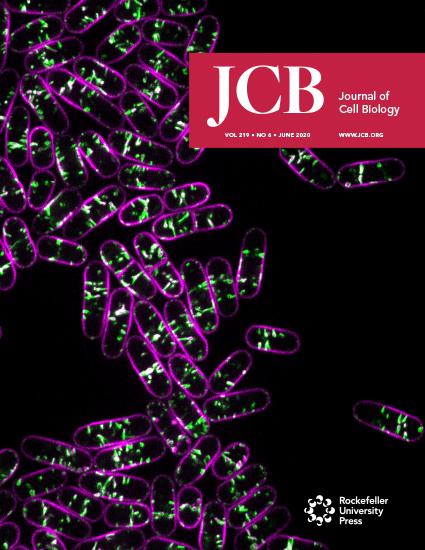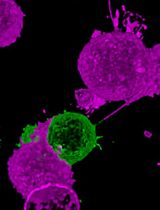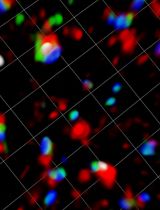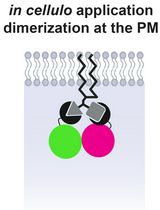- EN - English
- CN - 中文
Dual Color, Live Imaging of Vesicular Transport in Axons of Cultured Sensory Neurons
培养感觉神经元轴突囊泡运输的双色实时成像
发布: 2021年06月20日第11卷第12期 DOI: 10.21769/BioProtoc.4067 浏览次数: 3963
评审: Gal HaimovichKatrin DeinhardtMarzia Di Donato
Abstract
The function of neurons in afferent reception, integration, and generation of electrical activity relies on their strikingly polarized organization, characterized by distinct membrane domains. These domains have different compositions resulting from a combination of selective targeting and retention of membrane proteins. In neurons, most proteins are delivered from their site of synthesis in the soma to the axon via anterograde vesicular transport and undergo retrograde transport for redistribution and/or lysosomal degradation. A key question is whether proteins destined for the same domain are transported in separate vesicles for local assembly or whether these proteins are pre-assembled and co-transported in the same vesicles for delivery to their cognate domains. To assess the content of transport vesicles, one strategy relies on staining of sciatic nerves after ligation, which drives the accumulation of anterogradely and retrogradely transported vesicles on the proximal and distal side of the ligature, respectively. This approach may not permit confident assessment of the nature of the intracellular vesicles identified by staining, and analysis is limited to the availability of suitable antibodies. Here, we use dual color live imaging of proteins labeled with different fluorescent tags, visualizing anterograde and retrograde axonal transport of several proteins simultaneously. These proteins were expressed in rat dorsal root ganglion (DRG) neurons cultured alone or with Schwann cells under myelinating conditions to assess whether glial cells modify the patterns of axonal transport. Advantages of this protocol are the dynamic identification of transport vesicles and characterization of their content for various proteins that is not limited by available antibodies.
Keywords: Axonal transport (轴突输送)Background
Neurons are highly polarized cells. This polarity is critical for neuronal function, i.e., integrating pre-synaptic inputs on the somatodendritic compartment and initiating and propagating action potentials along axons. Myelinated axons are further subdivided into a series of sub-domains, notably including the nodes of Ranvier, the gaps located between adjacent myelin sheaths where action potentials regenerate during saltatory conduction. Nodes are highly enriched in voltage gated Na+ channels, their associated beta subunits, and several neuronal cell adhesion molecules (CAMs). Among the latter is neurofascin (NF) 186, which binds to cognate receptors on Schwann cells, the glial cells that myelinate axons in the peripheral nervous system. Sodium channels and CAMs at the node are tethered to and stabilized by interactions with ankyrin G (AnkG), which forms a specialized submembranous cytoskelon with βIV spectrin. Together, these components form a multimeric nodal complex that differs strikingly from that of other multimeric protein complexes present in other domains of myelinated axons (Salzer et al., 2008). These latter domains include the paranodes, which flank the node, and the juxtaparanodal and internodal domains, which lie underneath the compact myelin sheath.
A key question is whether the components of the node, and of other domains, are transported from the soma to the axon separately to be assembled locally or whether they are transported to their respective domains as pre-assembled complexes. Transport vesicles that shuttle transmembrane proteins from the cell body to the axon (i.e., anterogradely) would predominantly contain a single protein cargo in the former case, whereas they would contain a mixture of protein cargoes in the latter case. A related question is whether vesicles retrogradely transported from the axon to the soma also contain single or multiple cargoes.
One strategy to assess prospective co-expression of proteins in transport vesicles relies on immunofluorescence of proteins in sections of fixed ligated nerves (Cavalli et al., 2005). This method depends on the availability of suitable antibodies against the proteins of interest. In addition, the precise nature of the vesicles being visualized can be potentially ambiguous in the absence of active transport.
As an alternative strategy, we have dynamically imaged vesicles during active transport using multi-color live imaging, a powerful tool to characterize the transport of membrane proteins in neurons (Kaether et al., 2000). To examine whether components of the nodes are transported separately from each other, and from components of other domains, we first infected cultured rat dorsal root ganglia (DRG) neurons with a doxycycline-inducible lentiviral vector to drive simultaneous expression of various tagged proteins. These lentiviral-infected neurons were grown on poly-L-lysine (PLL)/laminin-coated glass bottom dishes either alone or with Schwann cells (SCs) under myelinating conditions. We then carried out pair-wise comparisons of these different cargoes in anterogradely and retrogradely transported vesicles by dual color live imaging and assessed whether vesicles contained single or multiple cargoes. Dynamic imaging allows for the unambiguous identification of vesicles undergoing active transport. Analyzing the transport of multiple proteins relies on distinct fluorescent tags of sufficient brightness to live image over extended time periods and does not require corresponding antibodies. Here, we provide a detailed protocol for dual-color live imaging of the transport of transmembrane proteins in cultured rat DRG neurons.
Materials and Reagents
35 mm glass bottom dishes (MatTek Corporation, catalog number: P35G-1.5-14-C)
100 mm tissue culture dishes (TPP, catalog number: 93100)
Syringe filter unit, 0.45 μm (Millipore Sigma, catalog number: SLHV033RS)
Timed pregnant Sprague Dawley rats (for E15-16 DRG dissection)
293FT cells (Thermo Fisher, catalog number: R7007)
Modified pSLIK (Addgene #25737; Shin et al., 2006) (storage at -20°C)
Modified pFUGW lentiviral vector (Addgene #14883; Lois et al., 2002) (storage at -20°C)
pCMV-VSV-G (gift from J. Milbrandt, Washington University) (storage at -20°C)
pCMV-Δ8.9 (gift from J. Milbrandt, Washington University) (storage at -20°C)
Note: pSLIK was engineered to remove hygromycin resistance and IRES sequences to provide additional space to accommodate larger cDNAs for various cargoes (Zhang et al., 2012). pFUGW was modified to lack the GFP reporter and to add a unique cloning site (Dzhashiashivili et al., 2007).
Gateway LR Clonase II Enzyme Mix (Thermo Fisher, catalog number: 11791020) (storage at -80°C)
Poly-L-lysine (Sigma-Aldrich, catalog number: P5899) (storage at -80°C)
Note: Used for 293FT cell culture.
Poly-L-lysine (Sigma-Aldrich, catalog number: P1274) (storage at -80°C)
Note: Used to coat glass bottom dishes.
Natural mouse laminin (Invitrogen, catalog number: 23017-015) (storage at -80°C)
Dulbecco’s phosphate-buffered saline (Lonza, catalog number: 17-512Q) (store at room temperature)
LipoD293 DNA transfection reagent (Signagen, catalog number: SL100668) (storage at 4°C)
0.25% trypsin (Thermo Fisher, catalog number: 15050065) (storage at -20°C)
Fetal bovine serum (Thermo Fisher, catalog number: 16000-044) (storage at -80°C)
MEM (Thermo Fisher, catalog number: 11090-073) (storage at 4°C)
MEM, minus phenol red (Thermo Fisher, catalog number: 51200-038) (storage at 4°C)
Neurobasal medium (Thermo Fisher, catalog number: 21103-049) (storage at 4°C)
Neurobasal medium, minus phenol red (Thermo Fisher, catalog number: 12348-017) (storage at 4°C)
DMEM (Lonza, catalog number: 12-614F) (storage at 4°C)
MEM non-essential amino acid solution (Thermo Fisher, catalog number: 11140050) (storage at 4°C)
Sodium pyruvate (Thermo Fisher, catalog number: 11360070) (storage at 4°C)
Glucose (Sigma-Aldrich, catalog number: G5146) (storage at 4°C)
L-Glutamine (Thermo Fisher, catalog number: 25030-081) (storage at -80°C)
B27 supplement (ThermoFisher, catalog number: 17504-054) (storage at -20°C)
2.5S nerve growth factor (AbD Serotec, catalog number: PMP04Z) (storage at -80°C)
Doxycycline (Sigma-Aldrich, catalog number: D9891) (storage at -80°C)
HEPES (Thermo Fisher, catalog number: 15630106) (storage at 4°C)
Penicillin-streptomycin (Thermo Fisher, catalog number: 15140122) (storage at -80°C)
Vitamin C (Sigma-Aldrich, catalog number: A0278) (storage at room temperature)
Fluorodexyuridine (FdU) (Sigma-Aldrich, catalog number: F0503) (storage at room temperature)
Uridine (Sigma-Aldrich, catalog number: U3003) (storage at room temperature)
HEK293 cell medium (see Recipes)
NB medium (see Recipes)
NBF medium (see Recipes)
C medium (see Recipes)
CF medium (see Recipes)
Live imaging medium (see Recipes)
Equipment
CO2 incubator (Thermo Fisher, model: Heracell 240)
Microscope and requirements:
Inverted epifluorescence microscope with plan Apo Lambda 100×/1.45 NA objective (Nikon, model: Eclipse Ti-E) equipped with a motorized Epi-fl rotating filter turret.
CCD cameras (Andor Technology, model: Clara; Nikon, model: DS-Qi2)
Heating Insert P (PECON, catalog number: 130-800 207)
Tempcontrol 37-2 digital (PECON, catalog number: 0503.000)
GFP filter cube (Nikon, catalog number: 96362)
594-nm laser bandpass set filter cube (Chroma, catalog number: 49911)
Software
NIS-Elements Advanced Research Software (Nikon, version: 4.30.01)
ImageJ Manual Tracking (Fiji, https://imagej.net/Manual_Tracking)
Excel (Microsoft, version: 2013)
Prism Software (GraphPad, version: 8)
Procedure
文章信息
版权信息
© 2021 The Authors; exclusive licensee Bio-protocol LLC.
如何引用
Bekku, Y. and Salzer, J. L. (2021). Dual Color, Live Imaging of Vesicular Transport in Axons of Cultured Sensory Neurons. Bio-protocol 11(12): e4067. DOI: 10.21769/BioProtoc.4067.
分类
神经科学 > 细胞机理 > 细胞分离和培养
神经科学 > 周围神经系统 > 施万细胞
细胞生物学 > 细胞成像 > 活细胞成像
您对这篇实验方法有问题吗?
在此处发布您的问题,我们将邀请本文作者来回答。同时,我们会将您的问题发布到Bio-protocol Exchange,以便寻求社区成员的帮助。
Share
Bluesky
X
Copy link












